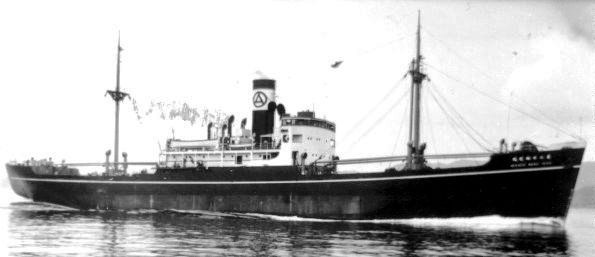RIKUGUN YUSOSEN
 (Sister MIKAGE MARU No. 20)
(Sister MIKAGE MARU No. 20)
SHOHO MARU:
Tabular Record of Movement
© 2017 Bob Hackett
1940:
Kobe. Laid down by Mitsubishi Jukogyo K.K. Kobe Zosensho (Mitsubishi Heavy Industries, Kobe Shipbuilding Yard) as a 2,723 ton cargo ship.
2 November 1940:
Launched and named SHOHO MARU.
8 March 1941:
Completed for Towa Kisen K.K., Kobe.
1 January 1943:
Requisitioned by the Imperial Army (IJA) as a troop transport. Alloted IJA No. 875.
27 February 1944:
SHOHO MARU departs Halmahera, Moluccas for Manokawari, New Guinea in a unknown convoy also consisting of passenger-cargo AKIURO MARU and freighter TOYO MARU and an unidentified escort.
LtCdr Cyrus C. Coles SS BALAO (SS285) sights smoke on the horizon and commences tracking the three ships and escort.
28 February 1944:
About 90 miles NW of Manokawari, New Guinea. Shortly after midnight, BALAO goes to battle stations and closes for attack. After firing her six bow tubes at the lead ship, she swings her stern toward the wing ships in the formation and fires her stern tubes. BALAO hears several explosions at the expected times, as torpedo after torpedo strikes home.
One of the ships trains a 3 in (76 mm) gun on BALAO, but a heavy internal explosion silences the gun before BALAO can be hit.
29 February 1944:
TOYO MARU picks up survivors and carries them to Manokawari.
Postwar study of Japanese shipping records identifies her victims as 2,723 ton SHOHO MARU, 34 men KIA, and 6,803-ton AKIURO MARU, 497 troops, 10 gunners and 55 crewmen KIA. Both ships sank at 00-15N,
132-53E.
Authors' Notes :
[1] Not to be confused with IJN cargo ship (1,936-tons GRT, '37), IJN requisitioned passenger/cargo ship (1,365, 42), IJA shared tanker No. 5158 (834 GRT, 44), civilian tug (430 GRT, 40),
civilian tanker (10,058 GRT 45), civilian cargo ships (1,356 GRT, 18) and (870 GRT, 44), or government passenger ferry (3,460 GRT, 24).
Thanks go to Erich Muehlthaler of Germany.
Bob Hackett
Back
to IJA Transports





